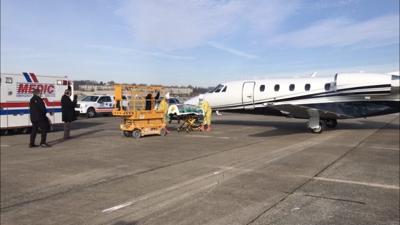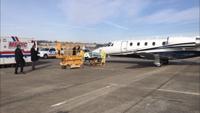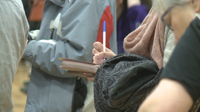IOWA CITY, Iowa (KWWL) — If an Eastern Iowan became infected by an unknown pathogen, like Ebola how would they be treated? The University of Iowa’s Hospitals and Clinic’s drilled for that today.
The drill first started at the Iowa City Municipal Airport where they practiced unloading the patient before heading over to the hospital.
Emergency Crews are getting their pretend patient, who is infected with an unknown pathogen like Ebola, loaded up into the plane that will “deliver” her. Once inside they will begin their drill. @KWWL pic.twitter.com/oD8htW7xRa
— Ashley Neighbor TV (@ashneighbor) December 11, 2018
Typically, The University of Nebraska’s Medical Unit is typically the first stop for this type of patient but if they are ever too full to take the patient, The University of Iowa is next in line. Today’s drill is all about making sure they’re prepared if need be.
A U of I student has been infected with an unknown pathegon after traveling to southeast asia, or at least that’s what they’re drilling for. Transporting and treating the patient is a complex job that requires a lot of practice.
“One of the things we had to look at is how would we unload a patient from an aircraft thats much larger than what would be seen in an airport like this,” said University of Iowa Hospitals and Clinic’s Emergency Management Coordinator, Michael Hartley.
From containment to transport there are many challenges, that the crew must do with patiences and precision.
“The interactions between the ambulance crew and our staff is an important interaction. so that we know how to work together and what each other can expect,” said Hartley.
A job like this can be nerve racking, especially while wearing a suit or PPE’s. Practicing makes it easier said Davenport Paramedic, Ben Anderson, “It takes the nerves, or the uncerainty out of it. That way you really are more comfortable to where you really have no major issues doing a call like this.”
The University of Iowa Hospitals were designated as a secondary biocontainment unit 4 years ago. Since then they haver continued to streamline their protocols.
“We are able to do it but do it so that they are absolutely no risk to the everyone else, no risk to the community, no risk to the state. That’s the challenge doing something like this,” said Hartley.
While having a full scale drill means a lot of time and coordination. Staff, like Davenport EMS Public Relations Manager, Jeremy Pessman say it’s worth it.
“We have to practice a lot because its just different, you lose dexterity wearing two or three pairs of gloves on, starting an IV can be difficult so we try to just practice and practice,” said Pressman.
“Bringing the patients in here and tranfereing to our crew is also a tedious proccess, so we learned how to do that a little smoother,” said Hartley.
Since 2014 they’re drilled this twice a year to make sure their plan doens’t just work on paper but in real life too.
In may they’ll do the drill again but this time being graded by different agencies.
Each time they pratice they focus on a different element. This year was the first time they practiced with a plane on the tarmac.
There are 50 other secondary containment unit’s accross the country like the one at the University of Iowa Hospitals.
There are 10 level one unit’s like the one in Nebraska.














